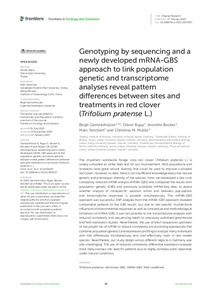| dc.date.accessioned | 2023-02-24T13:33:02Z | |
| dc.date.available | 2023-02-24T13:33:02Z | |
| dc.date.issued | 2023-01-17 | |
| dc.identifier | doi:10.17170/kobra-202302217521 | |
| dc.identifier.uri | http://hdl.handle.net/123456789/14446 | |
| dc.description.sponsorship | Gefördert durch den Publikationsfonds der Universität Kassel | ger |
| dc.language.iso | eng | eng |
| dc.rights | Namensnennung 4.0 International | * |
| dc.rights.uri | http://creativecommons.org/licenses/by/4.0/ | * |
| dc.subject | trifolium pratense | eng |
| dc.subject | red clover | eng |
| dc.subject | GBS | eng |
| dc.subject | mRNA-GBS | eng |
| dc.subject | field conditions | eng |
| dc.subject.ddc | 570 | |
| dc.subject.ddc | 580 | |
| dc.title | Genotyping by sequencing and a newly developed mRNA-GBS approach to link population genetic and transcriptome analyses reveal pattern differences between sites and treatments in red clover (Trifolium pratense L.) | eng |
| dc.type | Aufsatz | |
| dcterms.abstract | The important worldwide forage crop red clover (Trifolium pratense L.) is widely cultivated as cattle feed and for soil improvement. Wild populations and landraces have great natural diversity that could be used to improve cultivated red clover. However, to date, there is still insufficient knowledge about the natural genetic and phenotypic diversity of the species. Here, we developed a low-cost complexity reduced mRNA analysis (mRNA-GBS) and compared the results with population genetic (GBS) and previously published mRNA-Seq data, to assess whether analysis of intraspecific variation within and between populations and transcriptome responses is possible simultaneously. The mRNA-GBS approach was successful. SNP analyses from the mRNA-GBS approach revealed comparable patterns to the GBS results, but due to site-specific multifactorial influences of environmental responses as well as conceptual and methodological limitations of mRNA-GBS, it was not possible to link transcriptome analyses with reduced complexity and sequencing depth to previously published greenhouse and field expression studies. Nevertheless, the use of short sequences upstream of the poly(A) tail of mRNA to reduce complexity are promising approaches that combine population genetics and expression profiling to analyze many individuals with trait differences simultaneously and cost-effectively, even in non-model species. Nevertheless, our study design across different regions in Germany was also challenging. The use of reduced complexity differential expression analyses most likely overlays site-specific patterns due to highly complex plant responses under natural conditions. | eng |
| dcterms.accessRights | open access | |
| dcterms.creator | Gemeinholzer, Birgit | |
| dcterms.creator | Rupp, Oliver | |
| dcterms.creator | Becker, Annette | |
| dcterms.creator | Strickert, Marc | |
| dcterms.creator | Müller, Christina Magdalena | |
| dc.relation.doi | doi:10.3389/fevo.2022.1003057 | |
| dc.subject.swd | Rotklee | ger |
| dc.subject.swd | Genotypisierung | ger |
| dc.subject.swd | Messenger-RNS | ger |
| dc.subject.swd | Analyse | ger |
| dc.subject.swd | Biodiversität | ger |
| dc.type.version | publishedVersion | |
| dcterms.source.identifier | eissn:2296-701X | |
| dcterms.source.journal | Frontiers in Ecology and Evolution | eng |
| dcterms.source.volume | Volume 10 | |
| kup.iskup | false | |
| dcterms.source.articlenumber | 1003057 | |


